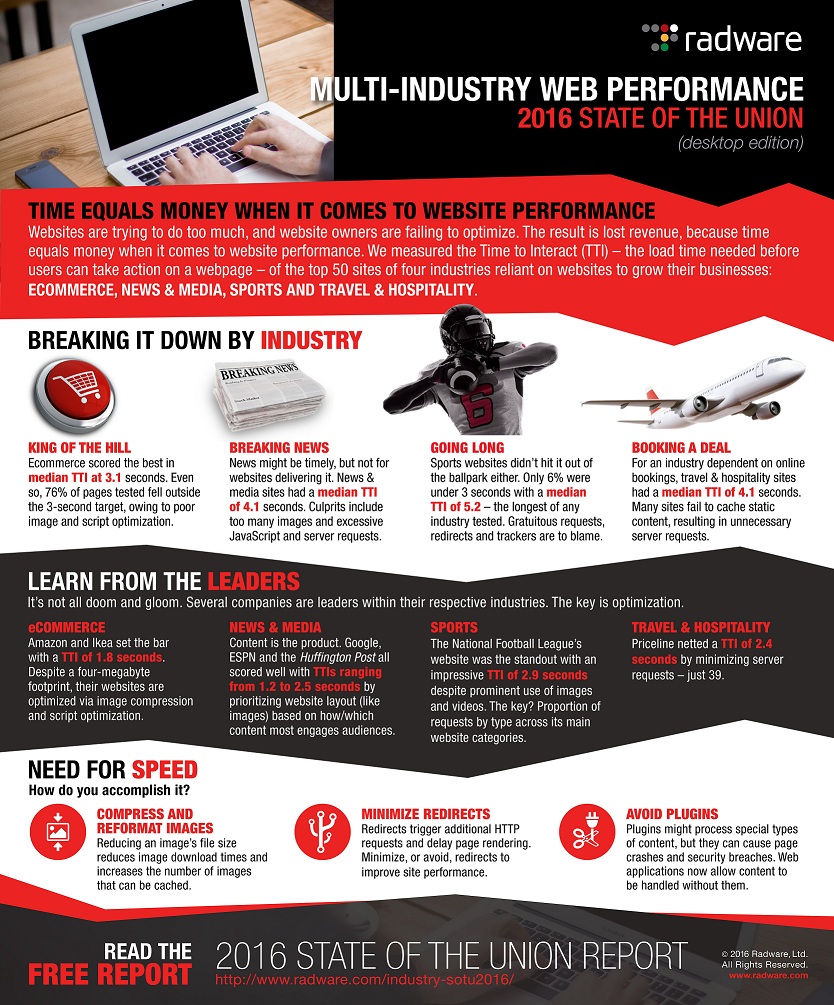Web pages know it takes a lot to catch — and hold — visitors' attention. That's why many sites are cramming their homepages with images, video and other content. But as they add more visuals, they're missing one core element: optimization.
Whether it's due to a steady uptick in the number of images, complicated JavaScript, or other plugins (all part of a push toward eye-catching pages), many sites are slow to load and need far too much time before users can interact with them. That's one of the key findings in Radware's 2016 State of the Union report on multi-industry web performance. See infographic below.

The report found that performance takes a hit as pages increase in total size as well as in the number of resource requests. This correlation is primarily due to page complexity and large, unoptimized images — two faults that ecommerce, travel, sports, and news websites are all guilty of.
These recurring trends threaten user retention and can undermine the bottom line since 57 percent of users will quit a website after three seconds, according to a study by Akami and PhoCusWright. This translates to abandoned shopping carts, unfinished travel bookings, unread articles, unseen ads, and missed opportunities to gain subscribers.
That has a major impact on revenue. According to the Centre for Retail Research, the average spend per person was around $115 in 2015 in the US. With 100,000 visitors per day and a 2 percent conversion rate, a bounce rate of 57 percent for a slow loading website will cost more than $130,000 of lost revenue per day:
(.57 x 100,000)(.02)(115) = $131,100
Businesses simply can't afford to overlook the impact of web performance — and yet the results show that too many are doing just that.
Sites across industries have built homepages based on what users want to accomplish — and similarly, what the respective industries want their users to do. As a result, the Radware report found significant variation in aspects like page size, composition, and the proportion of sites in each category failing to meet the three-second goal.
Overall, Radware found ecommerce sites to be the most optimized, with the highest percentage of sites within the three-second window, which is most likely due to smaller footprints and greater levels of optimization.
News and travel sites were the next best in the report. Their interaction time — a key metric for users — was roughly the same, despite travel sites using more visual content than news sites.
Sports sites tested the worst in page size, complexity, and the resultant load time users encountered, which is likely due to the large number of visual elements lacking optimization.
Luckily for these industries and others, there are a few best practices that websites can apply to improve the user experience. If your site takes longer than three seconds to load, try one or more of these tactics:
1. Compress and reformat images
Reducing an image's file size decreases download times and increases the number of images that can be cached.
2. Minimize redirects
Redirects trigger additional HTTP requests and delay page rendering. Minimize — or better yet, avoid — redirects to improve site performance.
3. Avoid plugins
Plugins might process special types of content, but they can cause page crashes and security breaches. Web applications now allow content to be handled without them.
Optimizing these three aspects of your website can mean more web traffic, more click-throughs, and happier users. They're small steps that can have a big impact, and in an ever-growing digital world, each second counts.
Study Methodology: Radware conducted this study within the United States in February 2016. Real-world performance of the top 50 global mobile travel industry websites, as ranked by SimilarWeb Ltd., was tested utilizing the Chrome 48 desktop browser, and the results were exported and analyzed.
Kent Alstad is VP of Acceleration at Radware.



